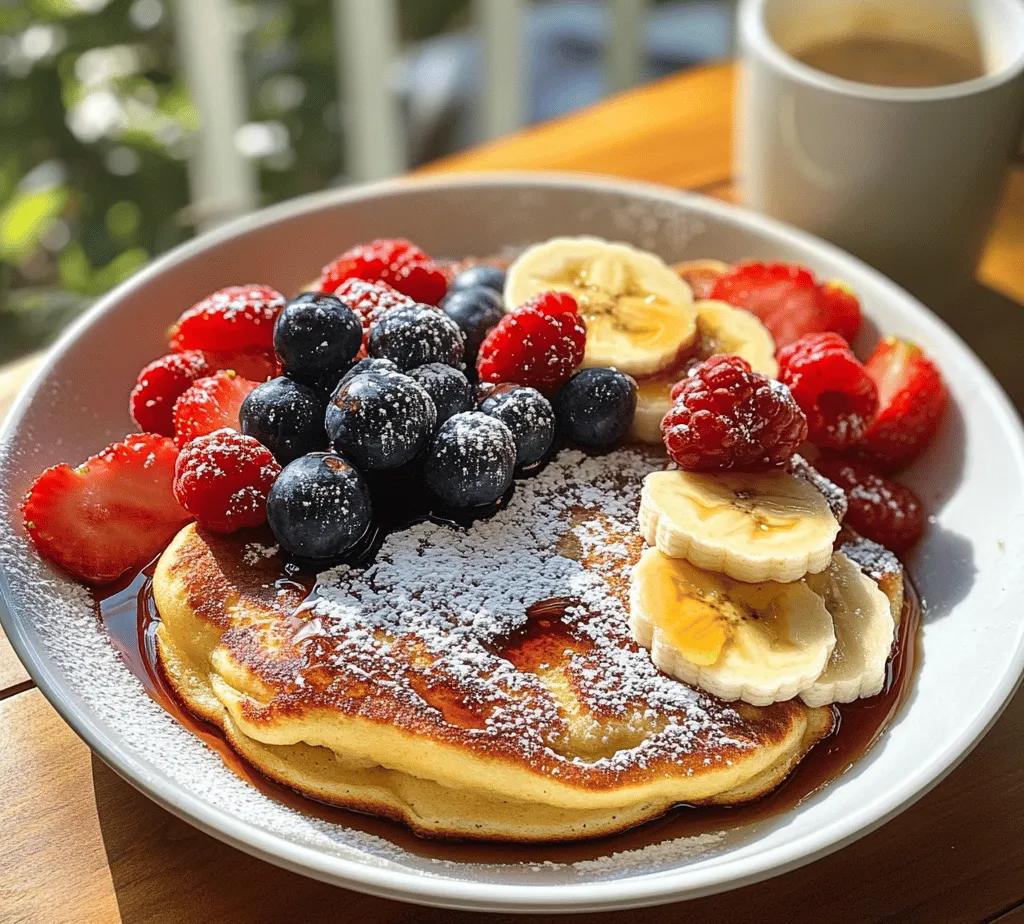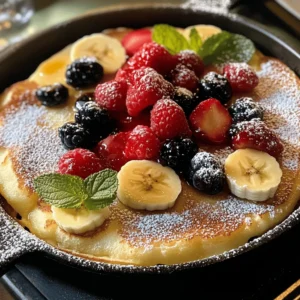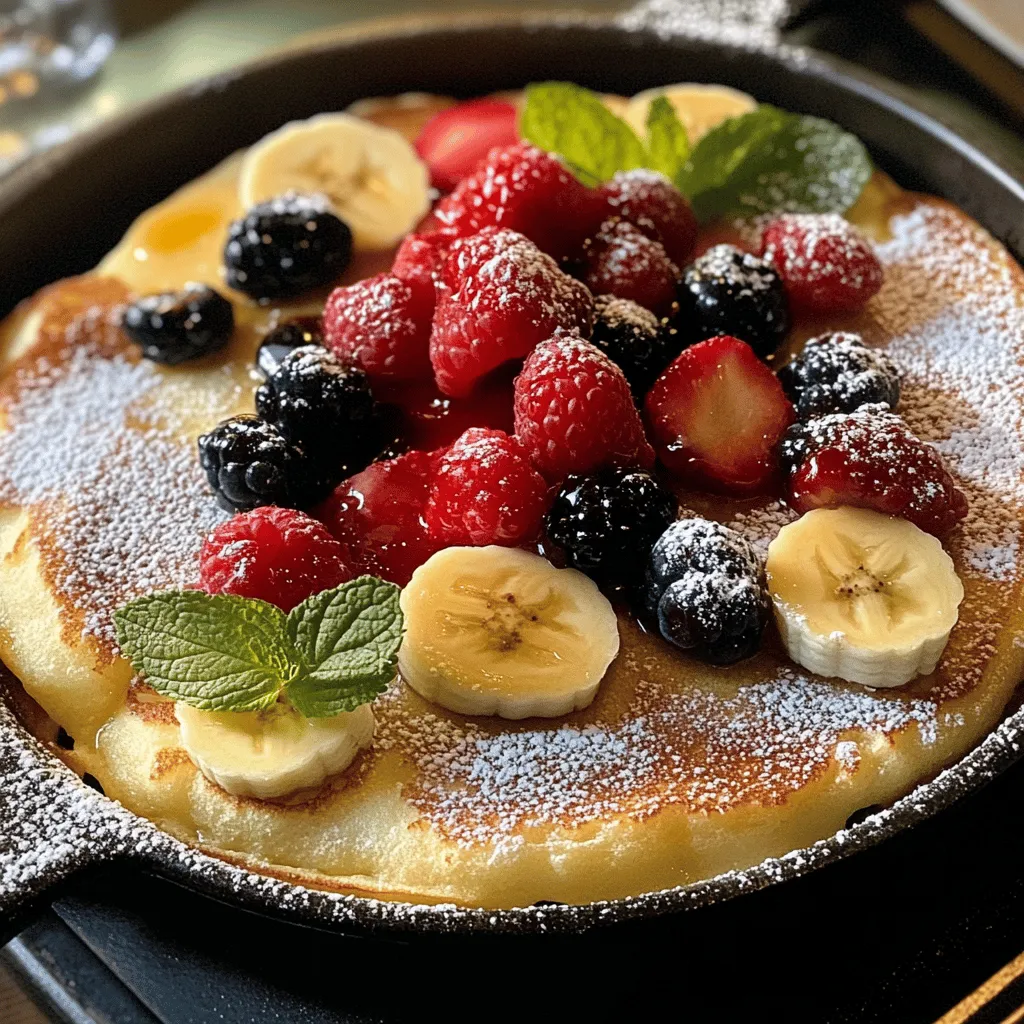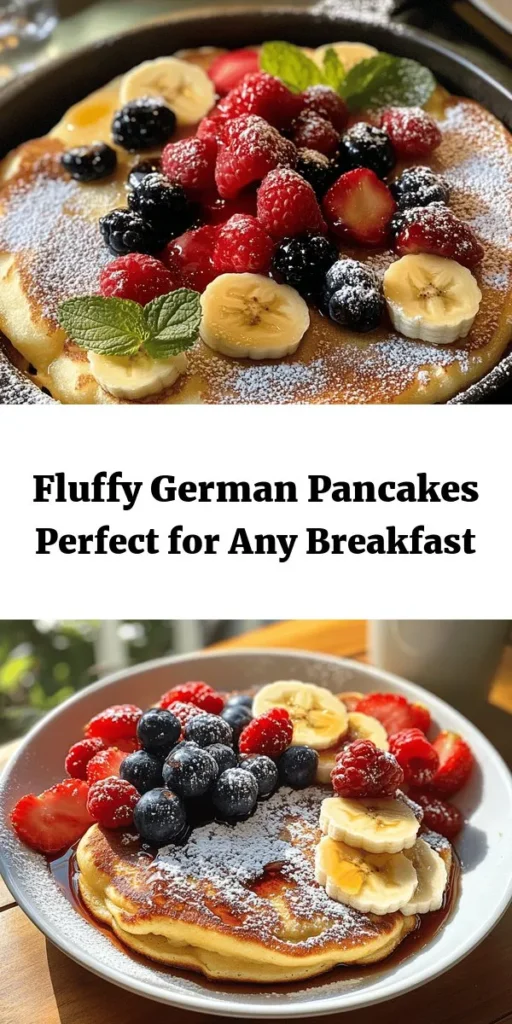When it comes to breakfast, few dishes can rival the delightful experience of Fluffy German Pancakes. These pancakes, often referred to as Dutch Babies, are known for their unique texture, which is both airy and custardy. Unlike their American pancake counterparts, which tend to be thick and fluffy, German pancakes puff up dramatically in the oven, creating a captivating presentation that is as pleasing to the eye as it is to the palate.
The magic of Fluffy German Pancakes lies in their versatility. Whether you prefer them drizzled with maple syrup, dusted with powdered sugar, or topped with fresh fruits, there’s no wrong way to enjoy this dish. This adaptability makes them an excellent choice for family breakfasts, brunch gatherings, or even a special treat on a lazy weekend morning. Best of all, the simplicity of the recipe ensures that both novice cooks and seasoned chefs can whip up a batch with ease, making it a beloved option across households.
Understanding German Pancakes: A Culinary Background
The origins of German pancakes can be traced back to the early 19th century, primarily in the regions of Germany and the Netherlands. Known for their rich culinary traditions, these countries contributed to the development of what we now recognize as German pancakes. The dish has evolved significantly over the years and has been embraced by various cultures, particularly in the United States, where it gained popularity in the 20th century.
Unlike traditional American pancakes, which are typically cooked on a griddle and served stacked, German pancakes are baked in the oven. This technique allows them to rise dramatically, creating a light, airy structure that sets them apart. The batter is poured into a hot, greased skillet, which helps achieve the desired puffiness as it cooks. The result is a golden-brown pancake that is soft and custardy on the inside, presenting a delicious contrast to its crispy edges.
Interestingly, the dish is often served in a more informal manner than its American counterpart. Rather than individual stacks, German pancakes are typically served in a single piece, allowing guests to cut their portions as they like. This communal aspect of serving adds to the charm of the dish, making it a perfect centerpiece for brunch tables.
Key Ingredients for Fluffy German Pancakes
To achieve the perfect Fluffy German Pancakes, understanding the role of each ingredient is crucial. Here’s a detailed breakdown of the essential ingredients that contribute to the delightful texture and flavor of this dish:
All-Purpose Flour
The foundation of any pancake batter, all-purpose flour provides the necessary structure. When combined with the other ingredients, it helps create the right balance of density and lightness, ensuring that the pancakes rise beautifully in the oven.
Milk
Milk is another key player in the batter, adding moisture that contributes to the pancakes’ fluffiness. It also helps create a smooth batter, allowing all the ingredients to blend together seamlessly. The fat content in milk enhances the overall flavor, making each bite more satisfying.
Eggs
Eggs are essential in binding the ingredients together and providing leavening. They contribute to the richness of the batter and help the pancakes achieve that characteristic puffiness. The proteins in eggs coagulate during cooking, creating a tender texture that is a hallmark of Fluffy German Pancakes.
Unsalted Butter
Melted unsalted butter is incorporated into the batter for both flavor and texture. It adds richness and helps to create a slightly crispy edge when the pancakes are baked. Using unsalted butter allows for better control of the overall saltiness of the dish.
Granulated Sugar
Granulated sugar serves to enhance the flavor of the pancakes and contributes to browning during the baking process. While not overly sweet, the sugar helps to balance the flavors and adds a subtle sweetness that complements the toppings.
Vanilla Extract
Vanilla extract is a simple yet impactful addition that elevates the flavor profile of the pancakes. It adds depth and warmth, making each bite more enjoyable. The aromatic qualities of vanilla also create an inviting aroma as the pancakes bake.
Salt
Although it may seem counterintuitive, a small pinch of salt is vital in bringing out the flavors of the other ingredients. It enhances the overall taste and balances the sweetness, ensuring that the pancakes are neither bland nor overly sweet.
Powdered Sugar and Fresh Fruits
For serving, powdered sugar and fresh fruits are often used as toppings. Powdered sugar adds a touch of elegance and sweetness, while fresh fruits provide a burst of flavor and color. Options like berries, sliced bananas, or citrus segments can brighten up the dish and make it visually appealing.
Step-by-Step Instructions for Making Fluffy German Pancakes
Now that we’ve explored the delightful background and key ingredients of Fluffy German Pancakes, let’s dive into the step-by-step instructions on how to prepare this delectable dish. The process is straightforward, ensuring that you can impress your family or guests with minimal effort.
Step 1: Preheat the Oven
Begin by preheating your oven to 425°F (220°C). This high temperature is crucial for achieving the signature puffiness of German pancakes. While the oven is heating, you can prepare your batter.
Step 2: Prepare the Baking Dish
Next, take a 9×13 inch baking dish or a cast-iron skillet and place it in the oven to heat up. This will help create a crisp bottom for the pancakes and encourage them to rise beautifully.
Step 3: Combine the Dry Ingredients
In a mixing bowl, whisk together the all-purpose flour, granulated sugar, and salt until well combined. This ensures that the sugar and salt are evenly distributed throughout the flour.
Step 4: Mix the Wet Ingredients
In a separate bowl, whisk together the eggs, milk, and vanilla extract. Make sure the eggs are well beaten to incorporate air, as this will further contribute to the fluffiness of the pancakes.
Step 5: Combine Wet and Dry Ingredients
Gradually pour the wet mixture into the dry ingredients, using a whisk to combine them until just blended. Be careful not to over-mix; a few lumps are perfectly fine. The batter should be smooth and pourable.
Step 6: Add Melted Butter
Once the batter is ready, remove the hot baking dish or skillet from the oven and pour in the melted unsalted butter. Quickly swirl the butter around to coat the bottom of the dish, then pour the pancake batter on top of the melted butter.
Step 7: Bake
Place the baking dish back in the oven and bake for 20-25 minutes, or until the edges are golden brown and the center is puffed up. Avoid opening the oven door during baking, as this can cause the pancakes to deflate.
Step 8: Serve Immediately
Once baked, remove the pancakes from the oven and serve immediately. They will begin to deflate quickly, so it’s best to enjoy them fresh out of the oven. Dust with powdered sugar and top with your favorite fresh fruits for an extra touch of flavor and presentation.
By following these steps, you can create a stunning and delicious breakfast that will be the highlight of your morning. Whether you’re serving them to family or enjoying them solo, Fluffy German Pancakes offer a delightful culinary experience that is sure to impress.

Preheating the Oven: Importance of Temperature in Achieving the Ideal Puff
Preheating your oven is a crucial step in making Fluffy German Pancakes. The ideal temperature for baking these delightful treats is typically around 425°F (220°C). This high temperature is essential for achieving the characteristic puffiness that makes these pancakes so special. When the batter is poured into a hot skillet and then placed in the oven, the sudden burst of heat quickly activates the eggs, causing steam to form and expand, which results in a light, airy texture.
Skipping the preheating step can lead to disappointing results. If the oven is not hot enough, the pancakes may not rise properly, resulting in a denser, less appealing texture. Therefore, always allow your oven to preheat for at least 10-15 minutes before baking your pancakes to ensure that they puff up beautifully.
Mixing the Batter: Tips for Ensuring a Smooth Batter Without Lumps
Once your oven is preheated, it’s time to mix the batter. The key to achieving a smooth batter lies in how you combine the ingredients. Begin by whisking the eggs in a large bowl until they are light and frothy. Incorporating air at this stage is critical, as it contributes to the final fluffiness of your pancakes.
Next, add in the milk and vanilla extract, mixing well. It’s best to use room temperature ingredients, as they blend more easily and create a smoother batter. Gradually sift in the flour, and be careful not to overmix. Overmixing can develop gluten, which may result in denser pancakes. Instead, gently fold the flour into the wet ingredients until just combined. It’s perfectly fine if there are a few small lumps; they will dissolve during cooking.
Preparing the Skillet: Importance of Using a Preheated Skillet for Best Results
While your batter rests, you can prepare your skillet. A heavy-bottomed skillet or a cast-iron pan works best for this recipe. Place the skillet in the oven for about 5 minutes, allowing it to heat up thoroughly. After this, carefully remove it using oven mitts and add a generous amount of butter to coat the surface. The butter should sizzle upon contact with the hot skillet, which is a sign that it’s ready for the batter.
Using a preheated skillet not only helps achieve that desirable puffiness but also prevents the pancakes from sticking. The hot butter creates a non-stick surface and gives the pancakes a beautiful golden-brown color. Ensure the skillet is evenly coated with melted butter before pouring in the batter.
Pouring and Baking: Techniques for Even Distribution of Batter and Achieving Even Baking
Now for the exciting part: pouring and baking! Pour the prepared batter into the hot skillet, ensuring an even distribution. The batter should sizzle as it hits the pan, which is a good indicator that the cooking process has begun. For best results, pour the batter in a circular motion to create a uniform pancake shape.
Once the batter is in the skillet, quickly return it to the oven. Avoid opening the oven door too soon, as the sudden drop in temperature can cause the pancakes to deflate. Bake for about 20-25 minutes, or until the edges are golden brown and the center is puffed and set.
To check for doneness, gently shake the skillet; the pancake should not wobble excessively. Once baked, remove the skillet from the oven and let the pancake rest for a few moments before cutting into it. This resting period allows the pancake to settle slightly while keeping its fluffy texture intact.
Serving Suggestions: Various Ways to Serve the Pancakes, Enhancing Their Appeal
Fluffy German Pancakes are incredibly versatile and can be served in numerous ways. Here are some delightful ideas to enhance their appeal:
1. Classic Toppings: The most traditional way to enjoy these pancakes is with a dusting of powdered sugar and a drizzle of fresh lemon juice. This combination brightens the dish and adds a refreshing contrast to the richness of the pancake.
2. Fruit Toppings: Seasonal fruits like berries, bananas, or peaches can elevate your pancake experience. Try sautéing apples with cinnamon for a warm topping or serving fresh strawberries with a dollop of whipped cream.
3. Syrups and Sauces: While maple syrup is a classic choice, consider experimenting with alternatives like homemade berry compote, chocolate sauce, or even a rich caramel drizzle. These add unique flavors and complement the fluffy texture of the pancakes.
4. Nuts and Seeds: For added crunch and nutrition, sprinkle chopped nuts like almonds or walnuts on top. They not only enhance the flavor but also provide a satisfying contrast to the softness of the pancake.
5. Yogurt and Cream: A dollop of Greek yogurt or whipped cream can bring creaminess to your dish. Consider flavored yogurts such as vanilla or honey for added sweetness.
The Science Behind Fluffy German Pancakes
Understanding the science behind Fluffy German Pancakes can help you master the art of making them. The key ingredient in this recipe is eggs, which play a crucial role in creating the pancake’s structure and fluffiness. When you whisk the eggs, you incorporate air, which expands during baking, helping the pancakes rise.
The combination of flour and milk also contributes to the texture. As the batter bakes, the proteins in the flour and the moisture from the milk interact, creating steam. This steam builds up within the batter, causing it to puff up significantly.
Moreover, the fat from the butter not only adds flavor but also aids in creating a tender crumb. It coats the proteins in the flour, preventing them from developing too much gluten. This results in a fluffy pancake rather than a dense one. Understanding these interactions between ingredients can help you troubleshoot and create the best version of these pancakes every time.
Customization and Topping Ideas for German Pancakes
One of the joys of Fluffy German Pancakes is their ability to be customized to cater to individual tastes. Here are some great ways to personalize your pancakes:
Fruit Variations
Seasonal fruits can transform your pancakes into a delightful dish. In spring and summer, fresh berries like strawberries, blueberries, or raspberries add a vibrant pop of color and flavor. In autumn, consider using sliced pears or apples, perhaps sautéed with a hint of cinnamon for a warm topping. The natural sweetness and acidity of the fruits enhance the overall flavor profile.
Sauces and Syrups
While maple syrup is a popular choice, there are plenty of alternatives to explore. Homemade fruit sauces, such as berry compote or peach syrup, can be made by simmering the fruits with sugar and a splash of lemon juice. For chocolate lovers, a rich chocolate sauce can make for a decadent breakfast treat. Additionally, for a savory twist, consider a drizzle of hollandaise sauce, which can complement the pancakes beautifully.
Flavor Enhancements
Enhancing the flavor of your batter can also elevate the experience. Adding a teaspoon of vanilla extract is a classic choice, but you can also experiment with spices like cinnamon, nutmeg, or even a hint of citrus zest. These additions bring warmth and depth to the flavor, making your pancakes even more delightful.
Nutritional Information and Health Considerations
Fluffy German Pancakes can be a nutritious addition to your breakfast table, but it’s essential to consider their nutritional content. A typical serving of pancakes made from the basic recipe contains a balance of carbohydrates, proteins, and fats. The eggs provide protein and healthy fats, while the flour contributes carbohydrates for energy.
For those with dietary restrictions, adaptations can be made. You can use gluten-free flour blends to create a gluten-free version of these pancakes. Similarly, for dairy-free options, substituting cow’s milk with almond milk or oat milk can make the recipe accessible to those with lactose intolerance or dairy allergies.
In terms of portion control, consider serving smaller pieces, especially when topped with rich syrups or sauces. This way, you can enjoy the flavors without overindulging.
Conclusion: Enjoying Fluffy German Pancakes as a Family Tradition
Fluffy German Pancakes are more than just a breakfast dish; they can become a cherished family tradition. The process of making these pancakes together can foster bonding moments, and the joy of watching them puff up in the oven is an experience that delights both young and old.
Encourage your family to experiment with different toppings, flavors, and customizations; this allows everyone to personalize their pancakes according to their preferences. The simplicity of this recipe, combined with its deliciousness, means that you can easily incorporate it into your weekend routine, celebrating the delightful start to your day.
Invite your loved ones to gather around the table and share in the delight that Fluffy German Pancakes bring. As you sit together enjoying this fluffy creation, you’ll likely find that the memories made around the breakfast table are truly the sweetest.



